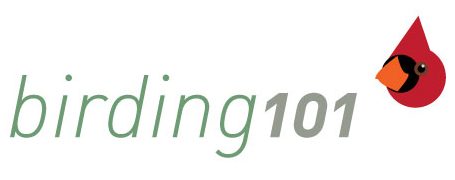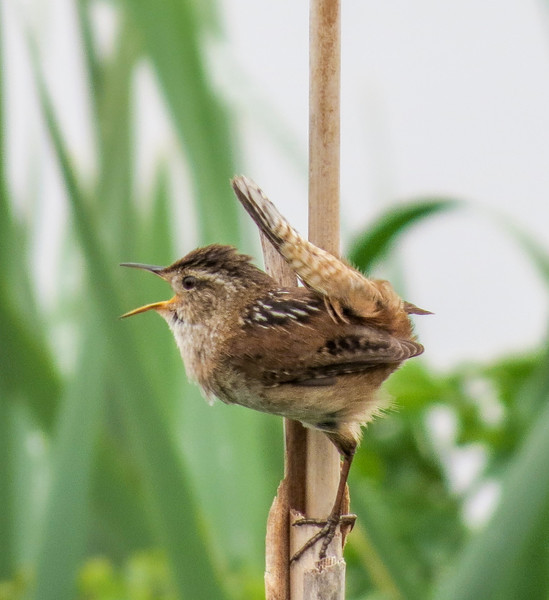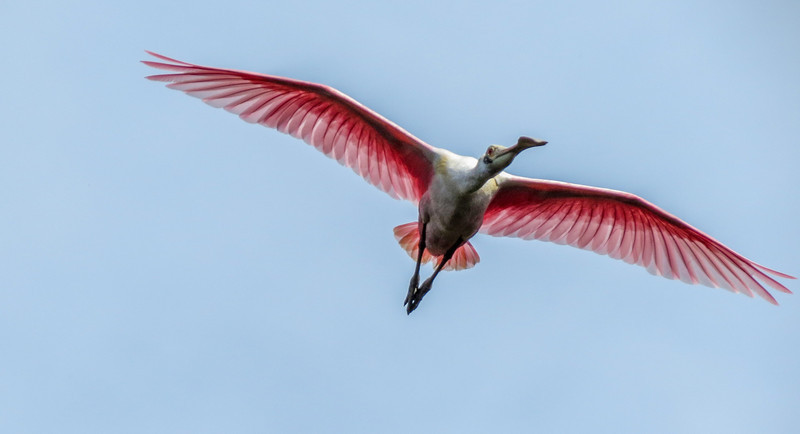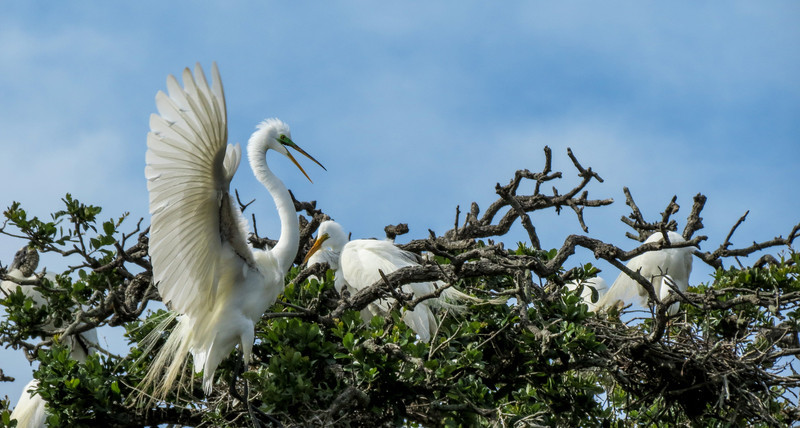Once upon a time, $25,000 and 35 pounds.
Once upon a time, oh, about 5 years ago, if you wanted to take satisfying photos of birds, you invested about $25,000 in equipment, which weighed about 35 pounds including a tripod or two, and you spent a lot of time in the field learning enough about birds to get close to them. You did most of your photography from a blind, sitting for days in the dark, set up as close to the birds as you could get, so you would have the best chance of filling the frame with the bird (and, because, honestly, no one carries 35 pounds of cameras and lenses and tripods further than they have to).
Using a camera to learn to bird was not an attractive option…and using a camera as your primary birding tool would have been considered insanity…and rightly so!
Today, Point & Shoot <$500 and 2 pounds.
Today, on the other hand, you can buy a super-zoom Point and Shoot from most camera makers for under $500…a camera that weighs under 2 pounds and fits in a small camera bag that you can carry over your shoulder all day without fatigue, and with which you can take frame filling photos of birds from as far away as, and often from much greater distances than, the guys and girls with the big lenses and expensive bodies.
The images will not be quite as good…but, with practice and persistence, they will be quite satisfying, and will often surprise you, and your fellow birders, with their quality. The birds in this piece were all taken with a super zoom P&S.
And, the inexpensive super-zoom Point & Shoot camera, coupled with the resources available today on the internet, opens up a whole new way of learning to bird.
So, if you were to go this route, what kind of camera are we talking about? A bit of advice here. Do your research first, before you get near a camera store or an on-line retailer. Check the reviews on dpreview.com and other similar sites. Pick a few cameras for your short list, based on the considerations below, and then read what users are saying about them on the dpreview forums. There is a lot of interest in using super-zoom P&Ss for bird and wildlife photography right now, so, for any camera worth considering, there will be posts in the forums which specifically address the topic. No bird or wildlife posts on the camera you are considering? Think again.
Once you have narrowed down your choices to one or two models, do a camera search on www.flickr.com and pull up sample images from each camera. That can tell you a lot about whether it is the camera you really want.
9 Considerations:
1. Long zoom.
You want the longest zoom you can find, consistent with the other considerations below. For the budding birder the long end of the zoom is more important than the short end…you want to be able to fill the frame with the bird from a reasonable distance…so you are looking for a camera with a zoom that reaches out over 600mm equivalent.
Equivalent: the actual focal lengths of Point & Shoot camera lenses are quite short compared to the focal length of the lenses used on full sized DSLR bodies (Digital Single Lens Reflex, cameras with a large digital sensor that take interchangeable lenses)…but the small size of the sensor makes them act like longer lenses…that is they provide the same sized frame, or field of view, as the longer lenses on full sized bodies. If you take a photo of a bird from the same distance with full sized DSLR and a 600mm lens, and with a Point & Shoot with a 600mm equivalent zoom, the bird will be the same size in the image.
There are several cameras out there today that reach into the 800mm and even the 1000mm range. The Canon SX50HS that I use reaches 1200mm optically (50x), but it has a built in Digital Tel-Converter that extends the range out to 2400mm and still returns decent quality…certainly enough for an id.
The zoom race is not over yet…each year one or more of the camera makers up the ante, stretching the zoom a bit further. (Fuji just announced the second P&S with a 50x zoom.)
2. Fast focus.
You want the fastest focus possible. Birds do not sit still, at least for long. You need to lock on focus as rapidly as possible, or the bird is likely to be gone. One of the disadvantages of most P&Ss, when compared to full sized DSLRs, is that they use a different, slower, less accurate auto focus system. And not all P&Ss are created equal in the focus department. Check the reviews on dpreview.com for focus speed ratings. You might trade a bit of zoom reach for faster focus. P&Ss are now reaching the market which feature fast focus as a selling point. Canon claims the SX50HS mentioned above focuses 40% faster than its immediate predecessor, and it does indeed…with more accurate focus at that.
3. Image stabilizer
You want efficient, reliable, image stabilization. Without image stabilization any shot over about 500mm taken without a tripod would require very fast shutter speeds…otherwise it would show motion blur from camera movement. There are two kinds of image stabilization: optical which moves elements in the lens to stabilize the image on the sensor, and sensor based, which moves the sensor to stabilize the image. In my experience (and I have owned and used both), the best optical image stabilization is far superior to any sensor based system. Efficient image stabilization will allow you to hand hold shots at 800-1000mm equivalents with confidence. I shoot at 2400mm with my Canon SX50HS hand held every day, with results that surprise even me.
4. Megapixel
You want a 12-16 megapixel sensor, most likely a Back-illuminated CMOS sensor. 12 megapixels is more than enough for high quality images. 16 mp will give you more ability to crop the bird out of the frame to make it larger when you don’t have enough optical reach in your zoom. BiCMOS sensors provide rapid continuous shooting, improved high-ISO performance (meaning that you can shoot in darker situations and use higher shutter speeds with confidence) and the ability to record HD video. All good things.
5. Continuous shooting.
You want the ability to shoot continuous frames at a reasonable speed. Continuous shooting means that the camera continues to take images, one after the other, as long as you hold the shutter down. The speed is measured in frames per second. You want 3-8 fps for both moving and stationary birds. For moving birds the advantage is obvious. You have a better chance of catching the bird in a satisfying position. For stationary birds, taking a burst of 3-5 images at 3-8 fps just increases your chance of getting a tack sharp image…especially if you are out at the ends of the zoom range where image stabilization is stressed to the max.
Many BiCMOS based P&S super zooms also have what is called burst mode (or they have burst mode instead of rapid continuous shooting…you need to be aware here, that some camera makes do not distinguish between the two, even though they are very different in use). Burst mode takes a rapid sequence of images, often at 8-12 frames per second, every time you press the shutter button. You see the difference? With continuous shooting you control the length of the burst by pressure on the shutter release. With burst mode a single press of the shutter release takes the whole burst. Burst mode is generally faster than continuous by several fps (reaching 10-12 fps), which is why many camera makes quote their burst mode rate as the frames per second rating for the camera. Buyer beware.
I like a camera with at least 3-4 fps true continuous shooting. I do not want to take 8 or 10 shots every time I press the shutter button, even when I am trying for rapidly moving birds…and when shooting stationary birds, a burst of 8 shots at 10 fps will give you 8 virtually identical frames, without any chance that one will be sharper than the others.
A final wrinkle to the whole fps thing: some cameras have two different continuous shooting rates: one with focus between shots and one without. Clearly there are advantages to having the camera focus between continuous frames, but it generally slows the frame rate significantly. There are a few cameras that provide true rapid continuous with focus…but in my experience even 4-8 fps without focus will work for the vast majority of birds.
Many P&S superzooms also feature a Sports Mode which is tailored to capture high speed action. The Canon SX50HS, for instance, has a Sports Mode that features focus tracking, and 5 fps with focus between frames. It is ideal for birds in flight…the first P&S Superzoom that makes bif relatively easy!
6. Image QualityYou want the highest image quality possible. Another of the disadvantages of P&S cameras is that images form the small sensors require a lot of in camera processing to produce reasonable image quality. The quality of that in camera processing, which generally you have no control over, varies from camera make to camera make, and from camera generation to camera generation. Remember when I said that no P&S is going to give you the same quality as an image from a full sized DSLR with a big sensor and a long lens…well it is a testimonial to the iniquity and creativity of the software engineers that work for the camera makers that they can even come as close as they do. In-camera processing is more art than science. Artistic decisions…what the team thinks the image should look like…drive the end results more than the math does. A digital image is a rendering…not a photograph in the literal sense…that means the scene was reduced to raw mathematical data by the sensor, and decisions have to make as to how to reconstruct, or render, the image so we can see it again. That is the source of the variation between camera makers and generations. In my experience, some makes get it better than others. That is to say that the software and in camera processing decisions they make consistently lead to images that are more pleasing to me than images from other cameras. That is not to say that they are inherently higher quality overall…just that they are more pleasing to my eye…better rendered. But it is a very subjective matter.
You will find image quality rated in reviews at dpreview.com and other such sites, and you will find it much discussed (debated) in the forums.
What I look for is:
- the rendition of fine detail…feather detail on birds…detail in foliage and grass, tree bark, architectural detail, etc. No blurring of fine details (out of focus blur is normal in background…but the in focus details should not run together as if someone dragged a wet brush across them).
- the smoothness of tones and the graduation between tones…no mottling or patchiness in face tones, blue sky, brightly painted walls, etc.) and an even blend from one shade of color to the next.
- no obvious digital artifacts…no blocky pixelization in solid tone areas, no color or brightness fringing along sharp contrast lines.
- true colors…believable sky blue, grass green…vivid authentic reds and yellows. Browns that do not get mushy.
- most importantly, just a pleasing rendition…close to what the eye would see from the depicted distance.
What I do is to read the reviews and get a general sense of how image quality is being rated for any given camera. Then I read what users are saying about the image quality in the forums. Then I look up as many examples of images taken with the camera (or its most recent sibling if it is a new camera). Then I buy the camera and test it myself. Sometimes I am delighted with my choice. Sometimes I am not. Like I say, I have learned which camera makers are most likely to produce an image quality that is pleasing to me, and I am now sticking pretty much to one brand.
7. HD video
You want full HD video at the highest frame rate you can get. Trust me. You do. (24 fps is adequate. I am waiting for a camera that has that looks to be as satisfying to me as my Canon SX50HS and has 60 fps!)
8. Portability
You want something small enough to carry everywhere you go. You want something durable enough to last a while, and with a solid enough feel to be satisfying in your hands. (But remember, at less than $500, often less than $400, camera makers rightly consider these cameras disposable…if you get 2 years out of a camera, well, by then something better will be out…and, imho, you got your money out of the camera anyway if you took as many pictures as you should have 🙂
9. Additional features.
You want what you want: creature features. Though you don’t need any of this for bird photography, I would never willingly buy a camera without:
- an effective macro mode…I take as many close ups as I do bird shots!
- an articulated LCD. I like low angle shots and shooting around corners and over heads and, as said, lots of macros…all of which are SO much easier with an flip out LCD, or a fully articulated one (flip out and rotate to practically any position)
- built in, easily controllable, flash. Sometimes it is just too dark.
So, those are my considerations. Taking that into account I have assembled a short list of cameras for you to compare. I will keep this list updated as new products come out, and rebuild the comparison table at dpreview.com which is linked in. Please note that not all the info is complete in the table. For some reason, for instance, there is no entry under Image Processor for the Canon SX40HS…which I happen to know is the Digic 5. Also note that the Canon SX500IS is a new camera, which, despite its shorter zoom and older Image Processor (Digic 4), is advertised to have much faster focusing than previous super zooms. And of course, my favorite to date is the Canon SX50HS mentioned so often above. (UPDATE: Prices given are those of Amazon.com Nov 12, 2015. And newer models mentioned by Stephen in the comments below have been added. Price for some of the older models are given as used).
- Canon SX40HS 12mp BiCMOS 24-840mm $135 (used)
- Canon SX50HS 12mp BiCMOS, 24-1200mm $330
- Canon SX500IS 16mp CCD, 24-720mm $229
- Fujifilm HS50EXR 16mp
$360
- Nikon P510 16mp BiCMOS, 24-1000mm $125 (used)
- Nikon P610 60x Optical Zoom
BiCMOS, 24–1440 mm (60x) $403
- Nikon P900 83x Optical Zoom BiCMOS, 24–2000 mm (83x) $499
- Olympus SP810 UZ 14mp CCD, 24-864mm $189
- Panasonic DCM FZ60 16mp CMOS, 25-600mm $280 (used)
- Sony DSC HX200V 18mp BiCMOS, 27-810mm $191 (used)
- Sony HX400V/B 20.4 mp
BiCMOS 24-1200mm $428
For a comparison chart, courtesy of dpreview.com go to Compare.
So there you have it. Short of buying your camera for you, that is the best I can do.
One final note.
Let taking photos of birds with your new super zoom be fun. Even if you are an experienced photographer, let the camera do the work. It is practically impossible to out-think the exposure systems built into today’s P&Ss. Put the camera on Program (just in case you want to adjust exposure compensation on occasion) and let it to its thing. Cultivate a Point and Shoot attitude. Just get lined up on the bird and hold the shutter button down for a few seconds. You will be surprised and delighted at the images you bring back. Like I said, all the images you see here were taken with a P&S super zoom…on program and auto focus. Let it be more about finding and enjoying the birds, observing what they are up to, where they are, how they behave…than it is about photography.
And you will have lots of fun. And you will learn to be a birder!
Stephen Ingraham
p4td.lightshedder.com
weiw.lightshedder.com
Top Photo: Yellow-headed Blackbird, ND. 1240mm. (840mm optical plus 1.5x digital tel-converter) Canon SX40HS (Stephen Ingraham)
Gunnar’s addition: I am currently using Canon SX40, but will upgrade to the SX50 very soon. Many people who bought the SX40 will probably do the same. I am very pleased with my SX40, but to get even better sharpness, more optical zoom and a faster auto-focus makes it a no-brainer to upgrade.
A used Canon SX40 could be a great gift to a kid who just starts getting interested in birds or to lure him/her into it, as explained in the intro-post. Currently they sell for just about $200 on eBay.com.
Whether buying a used SX40 or a new Olympus SP810 UZ could be a hard choice. I am sure Stephen will have some opinion. Check below in the comments section the following days.
If you haven’t already, why not start subscribing to this blog series.
If you liked this post, consider sharing with your friends who may be needing some advice.
Or leave a comment. You know, we love comments!
Affiliate links: All links to Amazon.com above are affiliate. That means if you click and purchase, we earn a very small commission which helps to run this website, and help paying for the upcoming production of the eBook. You don’t pay any more, and we get a contribution. Thanks for your support.





![IMG_3777-L[1]](https://birding.com.co/wp-content/uploads/2013/01/IMG_3777-L1.jpg)

